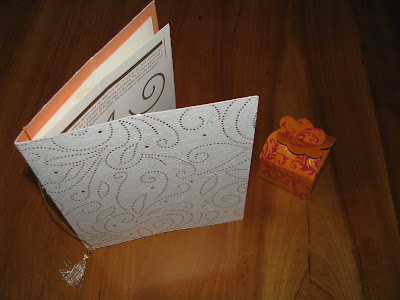 I collect Indian wedding invitations and cherish them. I think it's lovely to see a couple's and family's creativity and personality through the design, color, texture, etc. Of course we can't attend every Indian wedding as many of them take place in India, but I try to drag my poor husband to as many of them as possible, because when else would I get the chance to wear my sari's? Here are some of my favorite invitations that I've received over the past couple years...
I collect Indian wedding invitations and cherish them. I think it's lovely to see a couple's and family's creativity and personality through the design, color, texture, etc. Of course we can't attend every Indian wedding as many of them take place in India, but I try to drag my poor husband to as many of them as possible, because when else would I get the chance to wear my sari's? Here are some of my favorite invitations that I've received over the past couple years...


 The pretty sari material in the background was a wedding gift from one of Mahesh's cousins. One of the regrets I have about living in NY rather than India is small number of occasions where I could wear my traditional outfits.
The pretty sari material in the background was a wedding gift from one of Mahesh's cousins. One of the regrets I have about living in NY rather than India is small number of occasions where I could wear my traditional outfits.


 This invitation arrived in a padded, silk covered monogrammed box! Can you imagine my excitement?!
This invitation arrived in a padded, silk covered monogrammed box! Can you imagine my excitement?!  Uhh, yes. We were very busy at this extravagant wedding at the Beverly Hills Hotel of our cousin Ravi to the lovely Monica where my husband and his brother Anil from Hong Kong were also groomsmen. They recently welcomed a darling baby daughter into the world, that, ahem...I still need to meet.
Uhh, yes. We were very busy at this extravagant wedding at the Beverly Hills Hotel of our cousin Ravi to the lovely Monica where my husband and his brother Anil from Hong Kong were also groomsmen. They recently welcomed a darling baby daughter into the world, that, ahem...I still need to meet.

 Unfortunately we're invited to more weddings than we are able to attend and this was one of them. Yes, there are loose sequins under a clear plastic covering on the Sangeet invitation....I wonder what the party was like?!
Unfortunately we're invited to more weddings than we are able to attend and this was one of them. Yes, there are loose sequins under a clear plastic covering on the Sangeet invitation....I wonder what the party was like?!
 This romantic wedding of our dear cousin Anjali took place in Goa several weeks after our India trip, so consequently and sadly, we were not able to attend.
This romantic wedding of our dear cousin Anjali took place in Goa several weeks after our India trip, so consequently and sadly, we were not able to attend. 
 This is our announcement of our secret and low-key wedding last September. The delicate paper is sitting atop a gorgeous lengha that my auntie had made for me. My husband's family have been so warm and welcoming to me. Maybe we'll have our own Indian wedding one day. Shhhhh. Don't tell my husband--I'll have to surprise him.
This is our announcement of our secret and low-key wedding last September. The delicate paper is sitting atop a gorgeous lengha that my auntie had made for me. My husband's family have been so warm and welcoming to me. Maybe we'll have our own Indian wedding one day. Shhhhh. Don't tell my husband--I'll have to surprise him. 

 I finally had the pleasure of attending a wedding in India. In Mumbai, Mohit (another close cousin of my husband and now mine too) married his lovely bride Natasha. Having India as a backdrop for this wedding was truly a magical experience.
I finally had the pleasure of attending a wedding in India. In Mumbai, Mohit (another close cousin of my husband and now mine too) married his lovely bride Natasha. Having India as a backdrop for this wedding was truly a magical experience.
 Now, this invitation is resting on one of my favorite sari's that one of my aunties had made for me. It looks completely breathtaking on me, (my husband just wrote that, I promise).
Now, this invitation is resting on one of my favorite sari's that one of my aunties had made for me. It looks completely breathtaking on me, (my husband just wrote that, I promise).
 My good friend, Jules, who I met at Bhangra class several years ago, recently married her long-time sweetheart, Wakar in Pakistan. I live vicariously through their handsome wedding photos where Jules, the blond princess, looks like she was born to wear a wedding lengha.
My good friend, Jules, who I met at Bhangra class several years ago, recently married her long-time sweetheart, Wakar in Pakistan. I live vicariously through their handsome wedding photos where Jules, the blond princess, looks like she was born to wear a wedding lengha. 
 This is the invitation of our dear friends and "mad scientists" (they're actually just very smart Phd students with many other interests), Ram and Mary. Like us, they are also a lovely ethnic mix of Indian and American and had their wedding in Dallas. You can view Mary's enjoyable blog here.
This is the invitation of our dear friends and "mad scientists" (they're actually just very smart Phd students with many other interests), Ram and Mary. Like us, they are also a lovely ethnic mix of Indian and American and had their wedding in Dallas. You can view Mary's enjoyable blog here.

 This elaborate wedding took place at a castle in, would you believe, New York! During the Barat Nikashi (the welcoming of the groom), the groom rode in on an elaborately adorned white horse. The bride leaned over her half-moon balcony on the top floor of the castle in her wedding lengha, like a longing Juliet reaching down for her dearest. It was all quite over-the-top and dramatic, but extremely enjoyable and elegant.
This elaborate wedding took place at a castle in, would you believe, New York! During the Barat Nikashi (the welcoming of the groom), the groom rode in on an elaborately adorned white horse. The bride leaned over her half-moon balcony on the top floor of the castle in her wedding lengha, like a longing Juliet reaching down for her dearest. It was all quite over-the-top and dramatic, but extremely enjoyable and elegant.



 Just outside the gates of the temple, we walked through a stone path lined with women in brightly colored saris sitting on the floor and stringing orange and yellow marigolds and other flowers into garlands for the Gods. "5 rupees" they softly sang and swayed in harmony as they displayed their flowers for sale.
Just outside the gates of the temple, we walked through a stone path lined with women in brightly colored saris sitting on the floor and stringing orange and yellow marigolds and other flowers into garlands for the Gods. "5 rupees" they softly sang and swayed in harmony as they displayed their flowers for sale.


 The ancient Vaishnavite twin structures (10th-century) is set against a bright green lake. No longer in use like Eklingji is, these temples still have a quiet reverence surrounding them. I felt like an archaeologist in discovery. Exploring between the two structures, we had the entire place to ourselves...until a gigantic tour bus came charging in like a mad elephant and many many people wearing khaki shorts and sneakers stepped out and ran towards the structures, cameras in tote. So much for our peace and quiet; it was nice while it lasted.
The ancient Vaishnavite twin structures (10th-century) is set against a bright green lake. No longer in use like Eklingji is, these temples still have a quiet reverence surrounding them. I felt like an archaeologist in discovery. Exploring between the two structures, we had the entire place to ourselves...until a gigantic tour bus came charging in like a mad elephant and many many people wearing khaki shorts and sneakers stepped out and ran towards the structures, cameras in tote. So much for our peace and quiet; it was nice while it lasted.




















